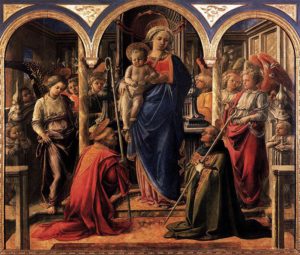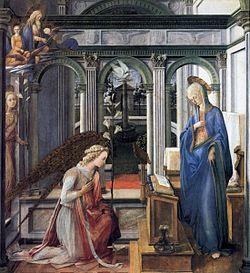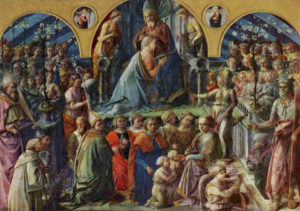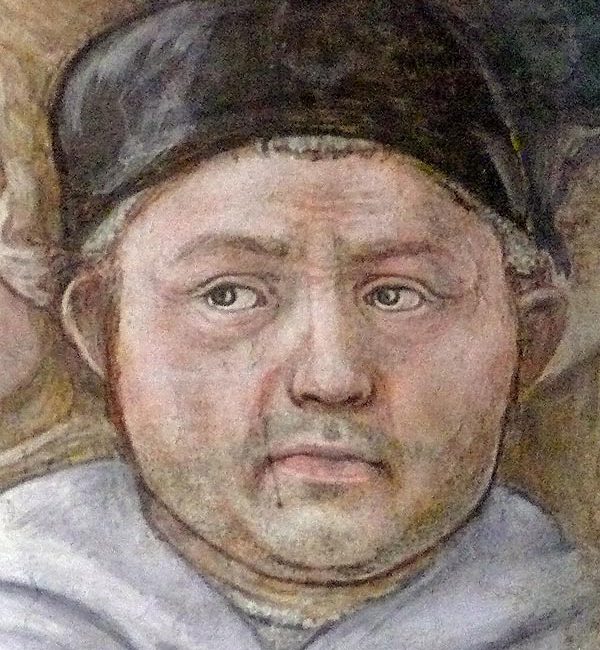Fra Filippo Lippi, also known as Filippo Lippi, died on the 8th of October 1469 in Spoleto, Papal States. Born in circa 1406 in Florence, he was one of the most important Italian painters of the Quattrocento – a painter in the second generation of Renaissance artists. Born into a large and poor family, Lippi became an orphan at a young age and was raised by his aunt, who due to her poverty eventually gave the child to the convent of Carmelite monks at Santa Maria del Carmine. At the time, Masaccio (born Tommaso di Giovanni di Simone Cassai) was painting a series of frescoes for the Brancacci chapel of the monastery. It was as though fate was guiding Lippi to meet with one of the most influential Renaissance painters of the time at a young age.

Lippi received his first contact with art at the monastery and painted frescoes in the church and in the cloister. According to Giorgio Vasari, he left in 1432, but then misfortunes beset him: Lippi was abducted by the Moors on the Adriatic and spent almost 2 years in their captivity until he painted his owner’s portrait. The history of this abduction, if it really happened, is shrouded in mystery – perhaps it is a product of fiction, for some things sound unrealistic to a remarkable degree. We know that in 1434, Lippi reappeared in Padua, but unfortunately there are no preserved works he painted during this time, although his style is recognized on some of Andrea Mantegna’s frescoes. Finally, the wheel of fortune turned in Lippi’s favor: in 1437, he came back to Florence and began working under the patronage of the wealthy and powerful Medici family.

When Filippo Lippi met Cosimo de’ Medici the Elder, he received important commissions. During his journeys, he honed his skills of a painter, which was reflected in his several altarpieces such as ‘Enthroned Madonna and the Child’ (1437) and ‘the Madonna and Child with Saints’ (1438). In his works executed soon after his return to Florence we can see Masaccio’s influence in Lippi’s style that started acquiring its own distinctive features expressed in the pictorial effect of bas-relief. This effect was made more apparent and beautiful by special lines, which in a way resembled the reliefs of some Florentine sculptors such as Donatello and Jacopo della Quercia.
The progressive development of Lippi’s style was reflected in his fresco ‘Annunciation,’ dated between 1443 and 1450. This painting depicts the Virgin Mary as she accepts her role as mother of Jesus, with a hand pressed to her breast where her heart is beating. The angel who informs Mary about the immaculate conception of Christ in her womb is kneeling next to her, also keeping a hand on his breast, as if symbolizing his earnest mood to deliver this marvelous news to her. The dove, which is a symbol of the Holy Spirit, is handed to her. The whole scene is framed into a portico opening to a close garden, just as it was often done by the painters of the era in religious frescoes. In the works Lippi completed between 1441 and 1445, we can see the warmth of his scenes where saints and angels are the main characters, and this warmth is enhanced by special shadings, approaching the limpid chromatics of his contemporary, Fra Angelico.

One of Lippi’s interesting works is ‘The Marsuppini Coronation.’ It depicts the Coronation of the Virgin, dated to after 1444. The panel was commissioned by the chancellor of the Venetian Republic, Carlo Marsuppini, for the St. Bernard Chapel in the church at Arezzo. Like in many of Lippi’s works, we see the heavy influence of Fra Angelico on his style despite its individuality. The panel, created in a sober and archaic style, is divided into 3 sections. The central one illustrates the scene of the coronation of the Virgin Mary: she is kneeling at the feet of Christ, who puts the crown on his head. At both sides there are symmetrical compositions of 3 musician angels and 2 standing saints in the foreground. We can see the new effects of perspective and skillful contrasts between color and form, in spite of the somber nature of the whole composition.
‘The Coronation of the Virgin,’ completed between 1441 and 1447, is very splendid and signifies a historic point in Italian painting because many figures are united in a brilliant way in one scene, while they could have been painted in various panels. The work is a single panel divided into 3 sectors by the arches. At the sides of the central arch are 2 tondos, portraying the Angel of Annunciation and the Virgin. The main scene depicts a multitude of biblical figures, angels, and saints in informal positions. This scene is set in heaven, but there is no outdated gilded background that had been popular during the Trecento – Lippi replaced it with a striped sky that alludes to the Paradise. In the middle, there are Jesus Christ and the kneeling Madonna who is going to be crowned, within a marble throne in perspective. In the lower level there are kneeling saints, as well as other saints and angels, among whom Mary Magdalene and St. Eustace are recognized. While his altarpieces are characterized by solemnity, some of Lippi’s paintings were quite vibrant.

Filippo Lippi was one of the first Florentine Renaissance painters to develop an intimacy of composition in religious genre. It becomes obvious if we take his painting ‘Madonna with Child,’ which can be found in Uffizi Gallery, Florence. Being one of the artist’s late Madonnas, this Madonna is more beautiful and more fashionable than any of his earlier Madonnas. The Madonna is portrayed in a chair, at the window of a house located on a hilltop, from where there is a view on a lovely landscape of plains, mountains in the distance, a city, and a bay. She is placed in front of an open window, which is unusual for the period. Madonna’s scrutiny is downcast, and her hands are folded in prayers before the baby Jesus, who is held up to her by 2 angels. Why is this Madonna called by art historians one of the most beautiful of the time? The woman is clad in an elegant and sumptuous coiffure with a veil and pearls, embodying style and elegance in accordance with the Renaissance standards. Lippi achieved such a closeness between the Madonna and the child that the entire composition has an air of warmth and sensitivity about her, which would become typical in works of Florentine painters of the next generation such as Sandro Botticelli. It was executed by Filippo Lippi during the last part of his career, between 1450 and 1465.

Filippo Lippi did not always live in Florence and had quite an adventurous life. In 1442, he was made rector of the church of San Quirico at Legnaia. Despite his monastic status, his life is associated with affairs, escapades of all sorts, and sometimes bizarre behavior. Some of them can be exaggerated, but Lippi was indeed a rake. In 1456, Lippi escaped from Prato, where he was painting in the convent of Santa Margherita, together with a young nun, Lucrezia Buti. From 1456 to 1458, the artist cohabitated with Lucrezia, although he was no longer a young man, and he also had liaisons with other nuns. His misconduct and his failure to finish his commissions by deadlines resulted in his arrest and trial. Thanks to Cosimo de’ Medici the Elder, Lippi was released and permitted to renounce his vows. At Cosimo’s request, the Pope allowed Lippi and the former nun – she repudiated her vows – to marry, and in this union, their son, Filippino Lippi, was born, who would later become a famous Florentine painter of the second half of the 15th century.
The city of Prato, located a short distance from Florence, was Lippi’s second beloved home. In his latest years, he spent much time at Prato, where he painted frescoes and altarpieces. Together with his friend, Fra Diamante, Lippi commenced redecorating the choir of Prato Cathedral there in in the late 1450s. Lippi and Diamante lived in the city from 1463 until 1467, painting frescoes for the cathedral in the chancel, with the 4 Evangelists and scenes from the lives of St. John the Baptist and St. Stephen. In 1467, Lippi, his son, and Diamante departed for Spoleto, where Lippi had to create the decorations and frescoes of the choir of Spoleto Cathedral, including the Nativity, the Annunciation, the Death of Mary, and the Coronation of Mary. These were Lippi’s final work as he died while in Spoleto. Later, the Medici financed the creation of a splendid sepulcher for the artist in 1490 in the Spoleto Cathedral, designed by Filippino Lippi, the painter’s son.
All images are in the public domain.
Text © 2020 Olivia Longueville





